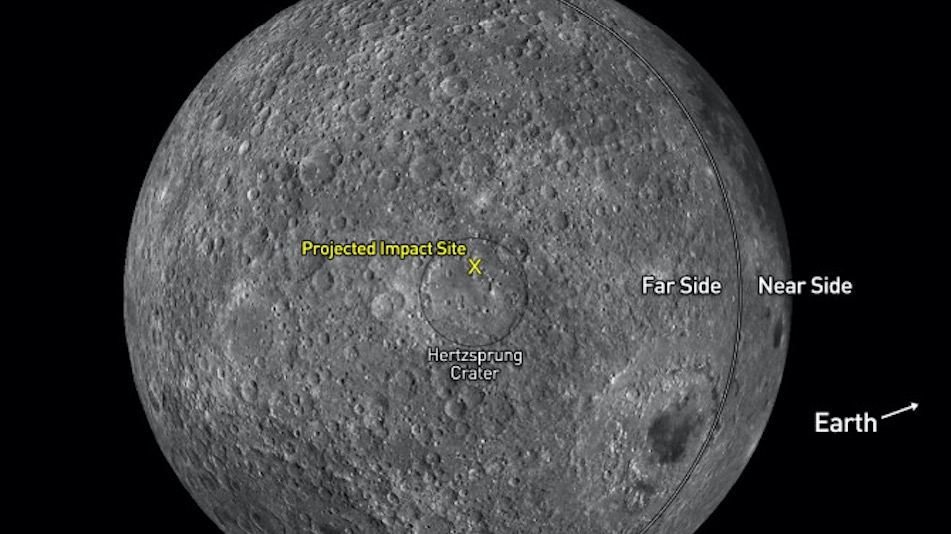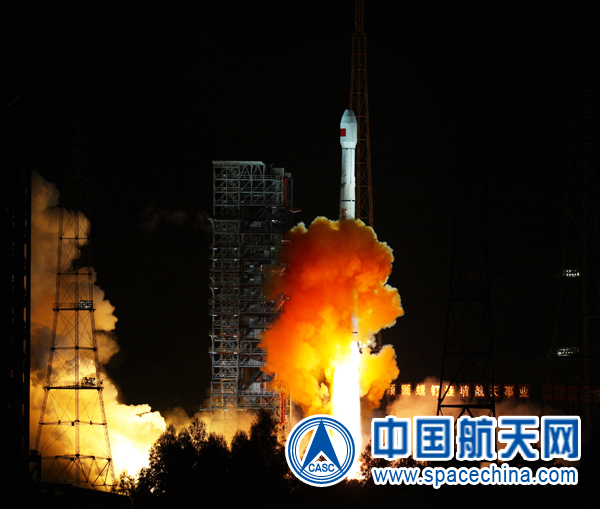
Scientists gearing up for rocket body's March 4 moon crash
There are plans to study the resulting crater.

A wayward rocket stage is poised to bombard the moon on Friday (March 4), and the coming impact has earned some scientific attention.
Reportedly, the Goldstone Solar System Radar near Barstow, California, is set to observe the object a few days before impact. And NASA's Lunar Reconnaissance Orbiter (LRO) will look for changes in the moon's exosphere — a very thin layer of gases — due to the crash and then later scan the lunar surface for the impact crater itself.
The rocket stage is on track to slam into Hertzsprung Crater on the far side of the moon on Friday at 7:25 a.m. EST (1225 GMT). The impact will mark the first time a piece of space junk accidentally smacks into the lunar surface, experts say. (This doesn't count the spacecraft that have crashed while attempting to land on the moon, or rocket bodies intentionally steered into Earth's nearest neighbor.)
Lunar mystery: Who launched the rocket that will slam into the moon?
More: The greatest moon crashes of all time
Rocket body identified
Originally, the rocket body was thought to be the upper stage of the SpaceX Falcon 9 rocket that launched the U.S. National Oceanic and Atmospheric Administration's Deep Space Climate Observatory (DSCOVR) in 2015.
However, the object is now tied to the Chinese Long March 3C rocket that launched China's Chang'e 5-T1 mission in 2014. Chang'e 5-T1 looped behind the moon and returned to Earth to test atmospheric re-entry capabilities for 2020's Chang'e 5 lunar sample return mission. Chang'e 5-T1 also carried a secondary payload of scientific instruments in the upper stage of the Long March rocket on behalf of the Luxembourg-based company LuxSpace.
Among the people who have made the China connection is Bill Gray, the manager of Project Pluto, which supplies astronomical software, both commercial and free, to amateur and professional astronomers.
Get the Space.com Newsletter
Breaking space news, the latest updates on rocket launches, skywatching events and more!
"There really is no good reason at this point to think the object is anything other than the Chang'e 5-T1 booster," Gray told Inside Outer Space last month. "Anybody claiming otherwise has a pretty large hill of evidence to overcome."
Video: Rocket stage to slam into moon, seen by Virtual Telescope Project

Cratering process
The March 4 crash will be broadly similar to impacts that occurred during NASA's Apollo program, when the third stages of huge Saturn V rockets were intentionally steered into the moon. In both cases, the moon-smacking projectile is more or less a tin can, explained Jeffrey Plescia, a planetary scientist at the Johns Hopkins University's Applied Physics Laboratory in Maryland.
"The result is that a lot of the energy goes into crushing the projectile rather than excavating the crater," Plescia told Inside Outer Space.
The Saturn V third stages created craters that are shallower than natural craters and sport an asymmetric shape, related for the most part to the low impact angle, Plescia added. "Always good to know the parameters of the projectile for better understanding the cratering process," he said.
Plescia noted that crater depth and other characteristics of the impact event will be more reliably measured for the March 4 crash, as pre-impact images have already been taken by LRO's powerful camera system.
"The only uncertainty at the moment is the orientation of the booster with respect to the trajectory. It is spinning, but whether it is just turning in rotisserie mode or tumbling is not clear," Plescia said. "I would hope the Chinese actually know this and would be forthcoming."
Paint of a different stripe
Enter Vishnu Reddy and his student researchers at the University of Arizona in Tucson, who have made observations of the errant upper stage.
Reddy and his team studied the rocket stage on Feb. 7, obtaining a spectrum of the object. They utilized the Rapid Astronomical Pointing Telescopes for Optical Reflectance Spectroscopy (RAPTORS) system, a telescope atop a building on the University of Arizona campus.
"Then we compared its spectrum to those of a Falcon 9 second-stage booster of similar provenance as the DSCOVR mission and a Chinese booster of similar provenance as the Chang'e 5-T1 mission," Reddy told Inside Outer Space. The differences in spectrum were chiefly due to the type of paint used by the Chinese, the team determined.
"Both these boosters were in Earth orbit and were launched around the same year as the Chang'e 5-T1," Reddy added. "The spectrum of the moon impactor matches the Chinese booster better than the SpaceX booster. Given the dynamical evidence cited by Bill Gray, we feel that our spectral observations are consistent with a Chinese origin."
"Radar will help pinpoint the impact location better as the booster is getting tossed around by solar radiation pressure," Reddy said. "It will still hit the far side of the moon around the Hertzsprung Crater area, but the impact point might shift a kilometer or so either way."
Leonard David is author of "Moon Rush: The New Space Race" (National Geographic, 2019). A longtime writer for Space.com, David has been reporting on the space industry for more than five decades. Follow us on Twitter @Spacedotcom or on Facebook.
Join our Space Forums to keep talking space on the latest missions, night sky and more! And if you have a news tip, correction or comment, let us know at: community@space.com.

Leonard David is an award-winning space journalist who has been reporting on space activities for more than 50 years. Currently writing as Space.com's Space Insider Columnist among his other projects, Leonard has authored numerous books on space exploration, Mars missions and more, with his latest being "Moon Rush: The New Space Race" published in 2019 by National Geographic. He also wrote "Mars: Our Future on the Red Planet" released in 2016 by National Geographic. Leonard has served as a correspondent for SpaceNews, Scientific American and Aerospace America for the AIAA. He has received many awards, including the first Ordway Award for Sustained Excellence in Spaceflight History in 2015 at the AAS Wernher von Braun Memorial Symposium. You can find out Leonard's latest project at his website and on Twitter.









